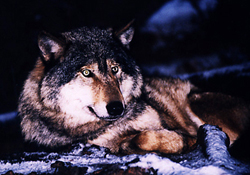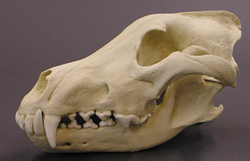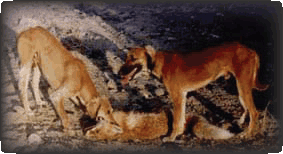Comparisons of morphology, physiology, and behavior and recent studies on mitochondrial DNA confirm that all breeds of dogs originated from one wild ancestor, the wolf. Today, the word primitive is used to describe those breeds of dog that may have been tamed but are, according to the available evidence, still close in morphology (appearance) and behavior (hunting style) to the dogs of 15,000 years ago.
Domestication of the wolf
Domestication of the wolf took place about 15,000 years ago in Asia, making the dog the first animal to be domesticated by humans. Below is a Siberian Wolf (Canis Lupus), the largest of the canids.

As you can see from the skull of the Siberian Wolf, below, it features powerful teeth. These wolves weigh up to 120 lbs and grow to 6 feet. Although highly social, wolves hunt both singly and in packs, observing a strict pack hierarchy. They feed on large herbivores and small animals.

A wolf can be tamed, or socialized, to humans. That is, however, not the same as domestication, which is the deliberate (and gradual) modification by selective breeding of a wild species over many generations into a docile animal that follows the will of humans. The tame wolf can be friendly and gentle, but even if tamed, it does not want to be restricted. It needs a very high and intense level of activity. Its natural intelligence and instincts prevent it from accepting confinement. Although they are capable of learning by observing, capable of repeating what they see humans do, wolves are difficult to train because they are only willing to do something for a purpose. Wolves have a very strong instinct for togetherness and common endeavor.
With migrations, wars and trade, dogs spread among human tribes of the world, eventually populating all continents and landscapes, from polar deserts to tropical rain forests. Yet the relative physical isolation of tribes of people was enough for differences to accumulate between dogs in different regions, even though the dogs mated freely without systematic selection for certain purposes by man.
All breeds are "native" to some area, where they were developed by natural and artificial selection as a local variety. The term aboriginal refers to a dog that was the first of its kind present in the region and often primitive, in that natural selection prevailed, based on survival of the fittest without selective breeding by man. The word aboriginal is applied to dogs of certain geographic regions of the world, where they have been discovered and described by travelers, ethnographers and naturalists.
Naturally, the history of dogs in every region is linked to the history of the people with whom they lived. Natural selection was a major factor of selection, but selection for qualities valued by people was also done, for example, when someone fed their most valuable bitch (female dog) or took her puppies inside during bad weather.
In some countries dogs still live as they lived thousands of years ago. When asked where from they got their dogs, local people often answered: “God gave them to us” or “They came from the skies”. The word primitive is used to describe those breeds that may have been tamed but are, according to the available evidence, still close in morphology and behavior to the dogs of 15,000 years ago. We can speak of primitive traits that refer to appearance, temperament, and hunting style. In general their appearance is recognizable in all countries by such "wild" characteristics as a nearly square body, wedge-shaped head with pointed muzzle, oblique set eyes, and prick ears. Primitive dogs may indeed represent one of the original or earliest known inhabitants of a country or region, having evolved with the original fauna or flora.
Primitive dogs with their plain wolf-like appearance have been faithful and undemanding assistants of plain folks, protectors of family and property of nomadic people. Aboriginal dogs used by people for physically active jobs or living free are built functionally correct, without excesses; their movement is economical, precise, well coordinated and effortless, like other wild animals. During hunting, pulling sleds, herding, or guarding property, they do not need regular treats for encouragement. Moreover, they often remain hungry for a long time and still keep working. Enthusiasm of a primitive working dog is explained by the fact that the process of work with the master is their best reward. During hunting, a primitive dog uses his entire set of senses given to him by nature in order to find the game, just as it would be done by a wolf. To deal with a big and dangerous animal, a dog must by bold but smart and never forget about the danger. Otherwise, he would be killed or injured, and his master would lose his assistant.
In some geographic regions, extinction of aboriginal dogs took place as a result of changes in the way of life of native people. As aboriginal dogs were displaced further and further away from economical centers (where human population is sparser and local people still retain their old way of life), many unique aboriginal dogs became extinct, became rare, or lost their identity because of mixing with imported, cultured breeds that, after selective breeding by man, no longer possessed their primitive morphologies or temperaments. Cultured breeds were found to be easier to control and more convenient to keep in overcrowded places. As even more selective breeding by man led to the modern concept of a "purebred" dog, those with a peculiar appearance became status symbols.
As a result, many aboriginal dog breeds lost their native behavioral instincts after generations of breeding for show qualities that emphasized appearance over working abilities. While excessive changes in anatomy and visible physical characteristics became “trade marks” of most breeds, they came at a price. Selective breeding weakened the dog's instinctual ability to survive harsh living conditions with little assistance from man and propagated health problems. |

Above is the picture of the Tazy, a primitive breed in Kazakhstan. (Biting muzzles is a behavior also observed in wolves, which is used to express dominance.)
Today, aboriginal dogs are still valued by many for their working qualities for guarding animal herds against coyotes, wolves, or other predators, for pulling sleds, or hunting. There are people who value aboriginal dogs simply because they are dogs of their ancestors, a part of their national heritage.
Both the American Rare Breed Association and the Primitive Aboriginal Dogs Society (PADS) list the Karelian Bear Dog and Russo-European Laika breeds among the primitive breeds. Formed in 1999, the Primitive Aboriginal Dogs Society (PADS) is a United States organization whose members share a common interest in the preservation of aboriginal dogs and education of the dog-loving public about the special value of aboriginal dogs.
The Russian branch of the International Society for the Preservation of Primitive Aboriginal Dogs (R-PADS) was founded to "unite people interested in the aboriginal dogs of Russia, regardless of whether they lived in the Russian Federation or beyond Russia’s borders." The founding members hoped that communication, exchange of information and coordination of efforts to preserve "these valuable dogs of our ancestors" and to assure their survival for future generations as unchanged and capable dogs who for centuries assisted people to survive in a harsh environment and shared with them the hardships of “uncivilized” life.
|